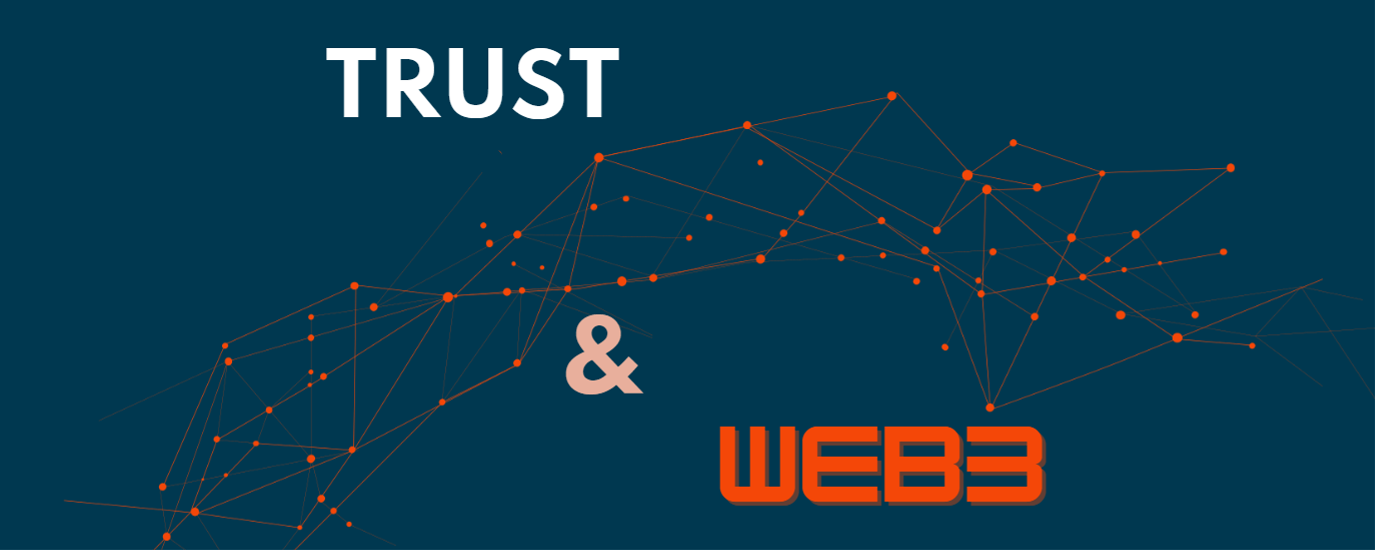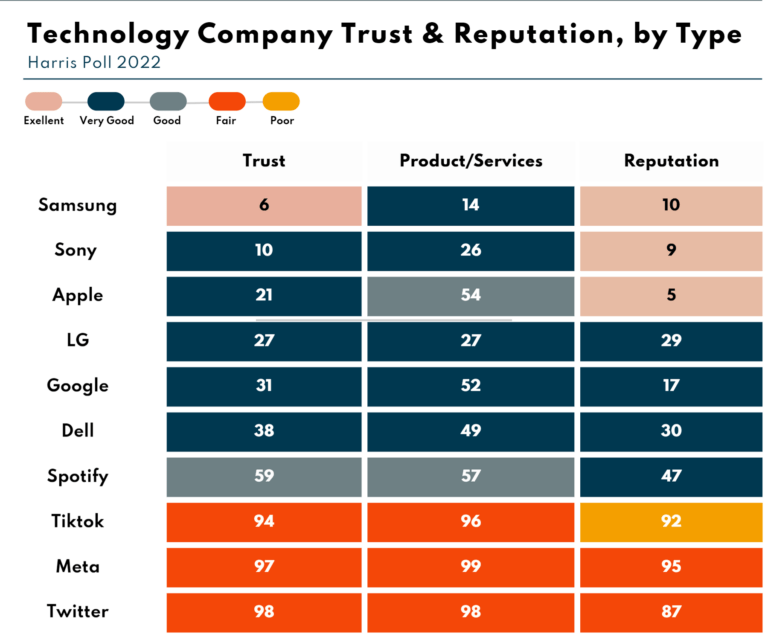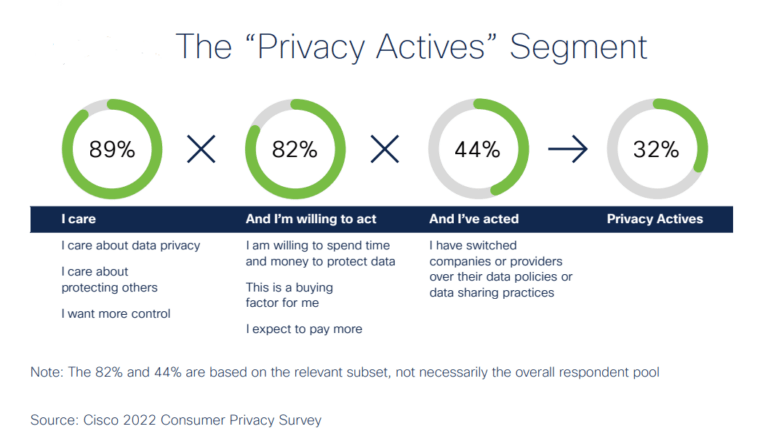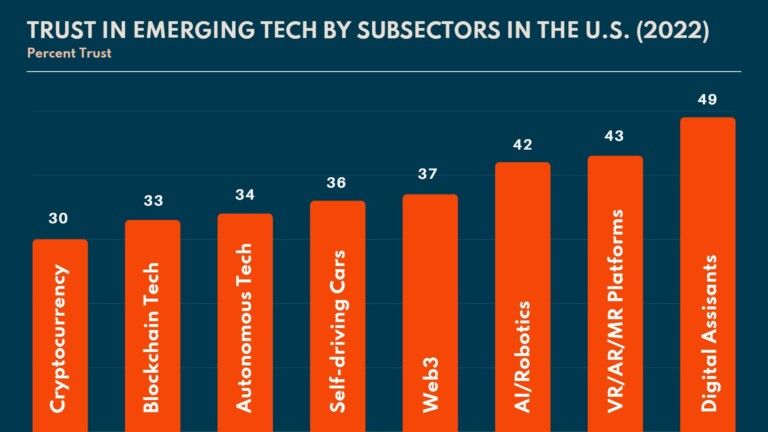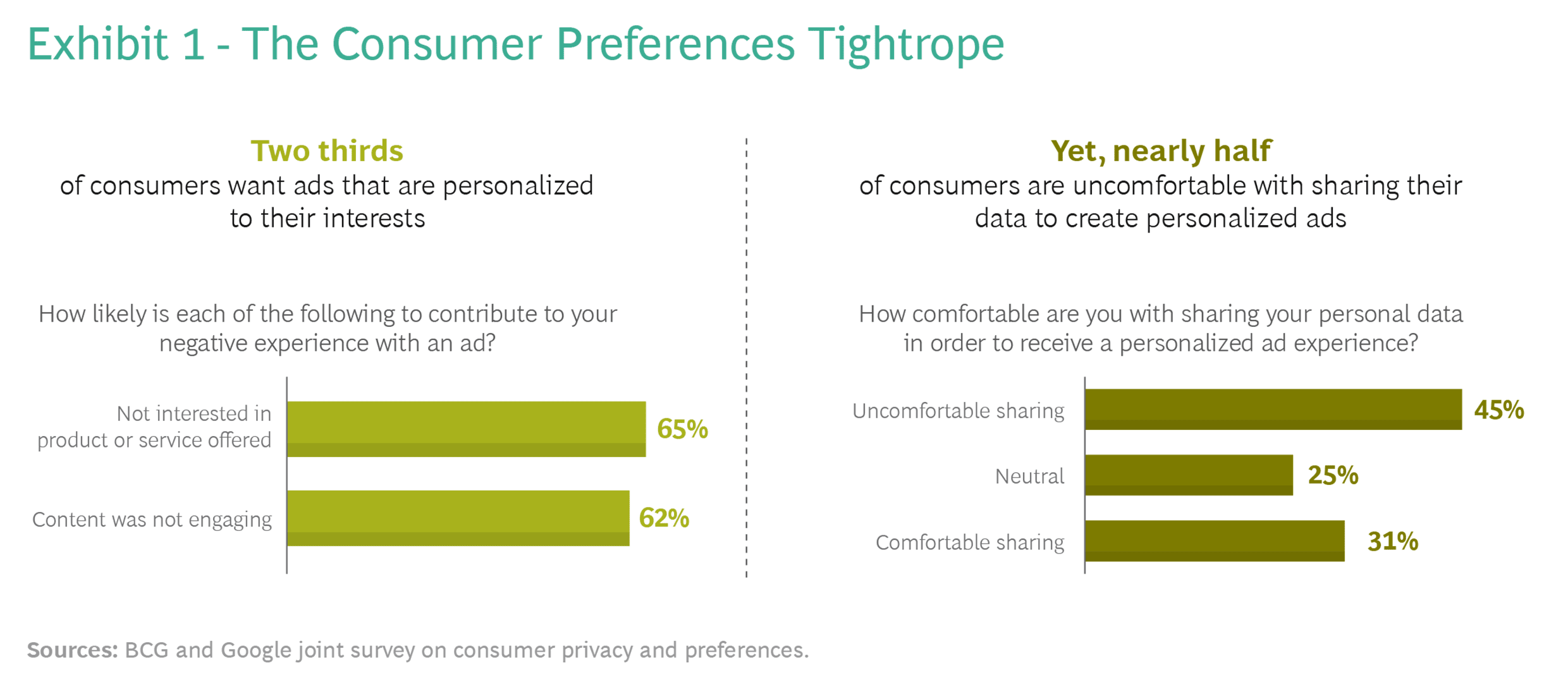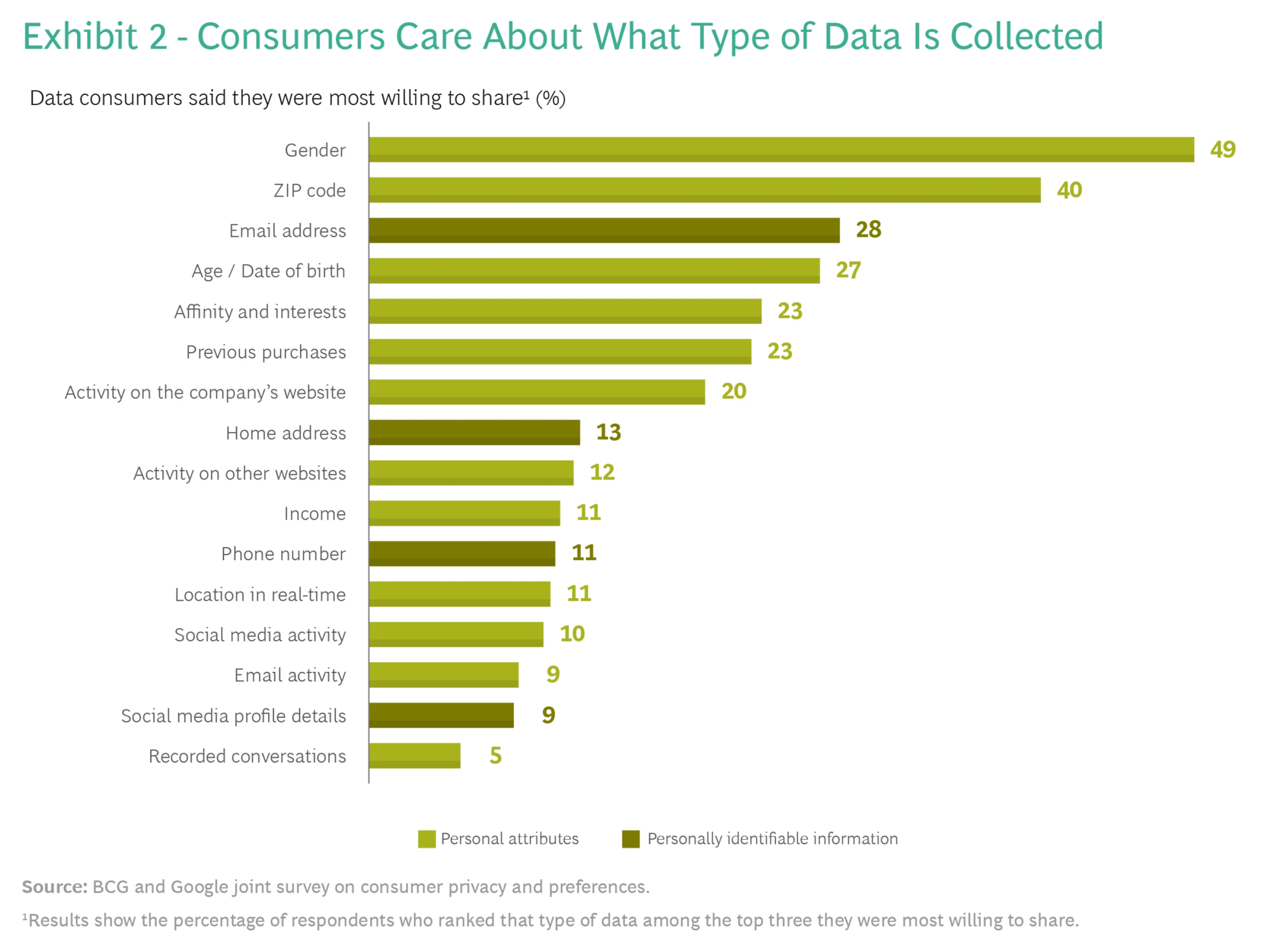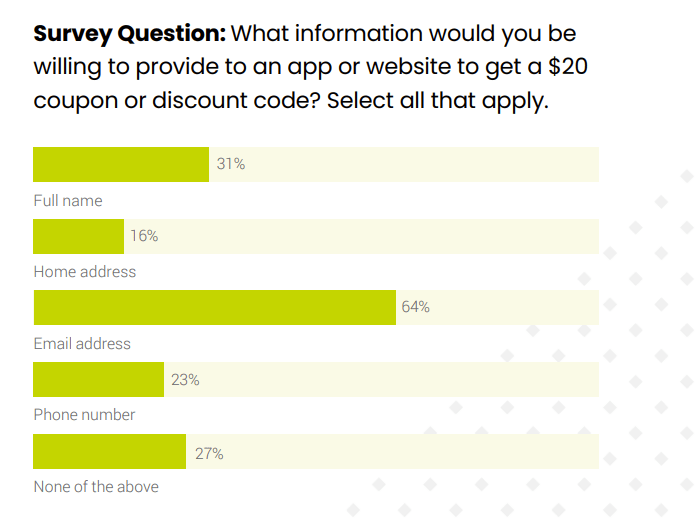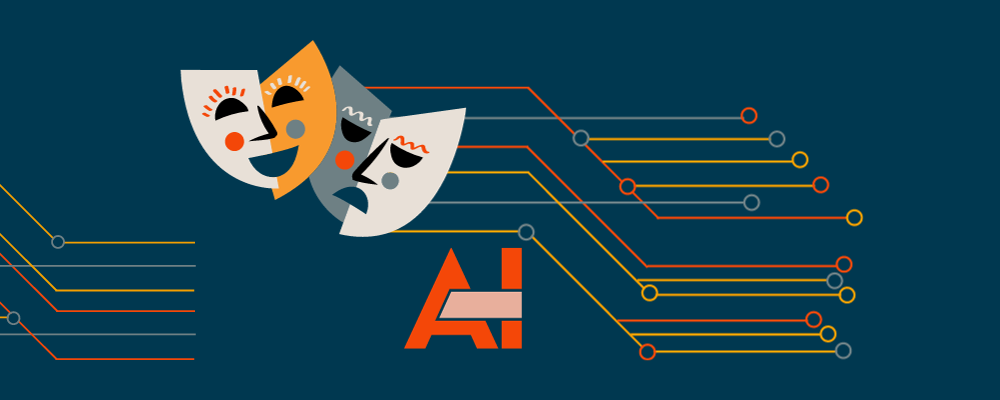For Web3 Power Brands, Trust is the Distinguishing Factor
“Trust is the glue of life,” Steven Covey once said. It’s the intangible force that binds us.
Trust is the ultimate currency in any relationship, because it empowers genuine connection and unwavering loyalty.
And trust has the power to make or break a brand, and it’s essential for its growth and sustainability. This isn’t news.
What is newsworthy is trust’s growing influence on purchasing decisions.
A recent study by Edelman reveals that brand trust has surged to become the 2nd most important purchasing factor, behind only price, across most geographies, age groups, gender and income levels.
This rise is due to consumers deeper dependence on brands, according to Edelman’s 2021 report on Trust and Brand Equity. And it’s particularly pronounced among younger consumers (ages 18-34).
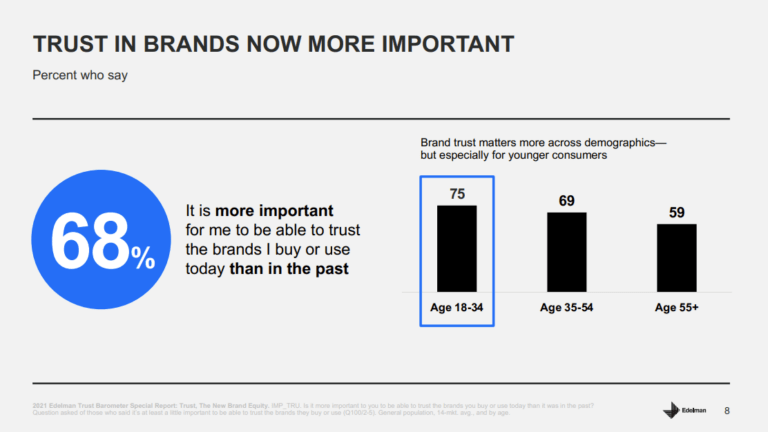
The report also highlights trust as the key driver of brand loyalty, especially in the face disruptions, controversy, and crisis.
In the midst of the global pandemic, consumers paid close attention to how brands addressed new challenges relating to their health, financial stability and data privacy.
And brand response had a big impact on consumer behavior. Edelman’s report reveals that 44% of consumers started using a new brand because of their response to the crisis, while 40% convinced others to stop using a brand due to their response.
Those are big numbers.
And in a post-COVID world, consumers have higher expectations of brands and more reasons to question their trustworthiness.
They ask themselves: “Will a brand protect my data and privacy? Use automation responsibly? Tell the truth in a world of disinformation?” In short, “Can I trust this brand to do the right thing?” Ultimately, consumers make their decisions based on their level of comfort with the brand’s anticipated actions.
What does this mean for future Web3 brands?
Well…..
For much of its history, the crypto / Web3 / NFT world has been plagued by fraud and its association with ponzi schemes and rug-pulls. Lack of trust has been one of the biggest barriers to mainstream adoption of the ideas, tech and culture of web3.
Recent scandals in the crypto world have added fuel to this fire. The collapse of Sam Bankman-Fried’s FTX deepened consumer skepticism and distrust, casting an even darker shadow.
To the skeptics, FTX’s failure suggests that the crypto world still doesn’t have a solid grasp of the basics. If one of the largest currency exchanges can’t be trusted to manage trading or handle customer assets ethically, why should anyone trust other businesses or brands in this space?
These are real, legitimate and challenging questions.
Yet here’s the silver lining: In this realm, where trust has always been scarce and is now shattered, a brand built on trust will have a unique and powerful advantage.
But is it possible to (re)build trust in this climate? And will the rapid evolution of emerging tech allow for that chance?
As you can probably tell, I believe the answer is yes.
But before we delve into more specifics, let’s take a closer look at the state of trust within the broader tech industry, as consumer sentiment there will influence overall trust levels for emerging tech and web3.
For this process, I’ve curated insights from multiple sources with a critical eye towards biases and agendas, so we can examine them through a “clean” lens. Especially because many companies who commission or finance the research often have a vested interest in the outcome, and offer products and services addressing the very challenges surfaced by the studies.
If you want my take on what makes a brand strong, check out the manifesto I wrote, included below.
And in case you prefer to skip to specific sections of this post, click on section headers below.
The State of Trust in Tech: Key Insights
Tech is still the most trusted sector in business, according to Edelman’s 2022 Special Report: Trust in Tech. However, a growing body of research from recent years including Edelman’s own yearly Trust Barometer Reports highlight the tech industry’s struggle to maintain its grasp on public trust, which has been on a downward spiral.
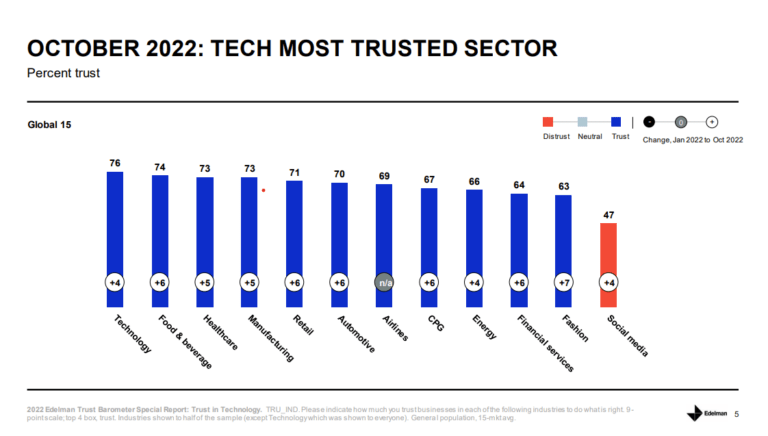
Trust in tech overall declined 24% over the past decade in the U.S. waning across all demographics, based on data from Edelman’s 2022 Special Report: Trust in Tech.
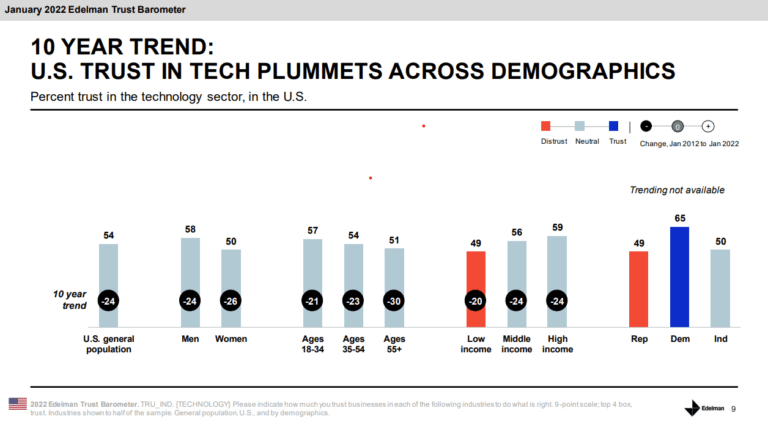
There’s a higher level of distrust amongst older adults, low-income earners and self-identifying Republicans (+16% vs. their Democrat counterparts).
Part of the decline is due to consumers’ shifting and broader definition of technology, which groups typically reputable hardware and software companies with less trustworthy social media brands. 90% of consumers categorize social media and apps as tech, which drives trust levels down for the entire sector.
91%
of consumers’ definition of tech includes social media and / or digital apps
In developed markets, consumers are
10%
less likely to trust the tech sector if social media is part of their definition
The Tech Industry’s Big Trust Gap
The insights from The 2002 Harris Poll 100, which measures the reputation of the top 100 brands in the U.S., supports the findings from the Edelman reports.
There are a few key points worth noting:
Consumer Concerns on the Rise
Growing concerns over data privacy (73%), cybersecurity (71%), rising misinformation (73%), deep fakes (65%) and bias in artificial intelligence (60%) have all contributed to the erosion of trust.

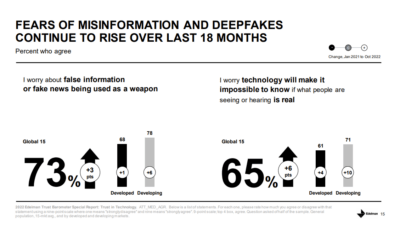
And they’re willing to act to protect their privacy. According to Cisco’s 2022 Consumer Privacy Survey, 32% of consumers – a segment they refer to as “Privacy Actives “– are not only willing to take action to protect their privacy, but have already switched companies or providers to do so.
Emerging Technologies and The Trust-Adoption Connection
Globally, consumers are more wary and less trustful of emerging technologies than the overall tech sector. This is understandable given that new tech is often unfamiliar and untested, creating uncertainty and doubt in the minds of consumers. As a result, lower levels of trust lead to lower rates of adoption.
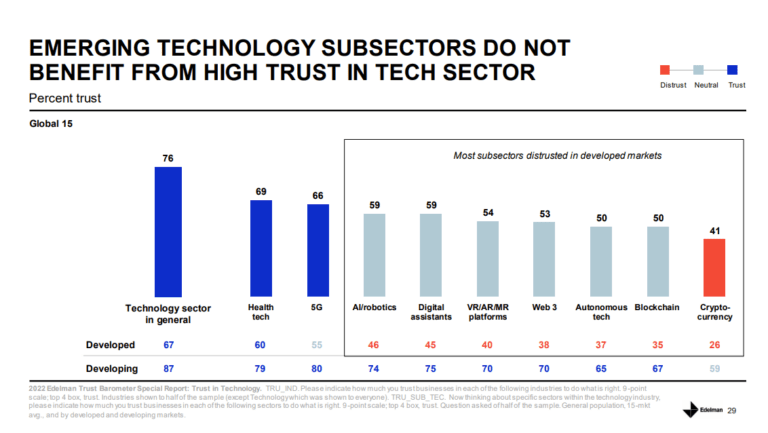
In developed markets, consumers are less trusting of emerging tech including cryptocurrency (26%), blockchain (35%) autonomous tech (37%) and web3 (38%).
A mere 10% consider themselves to be first adopters, compared to 33% in developing markets.
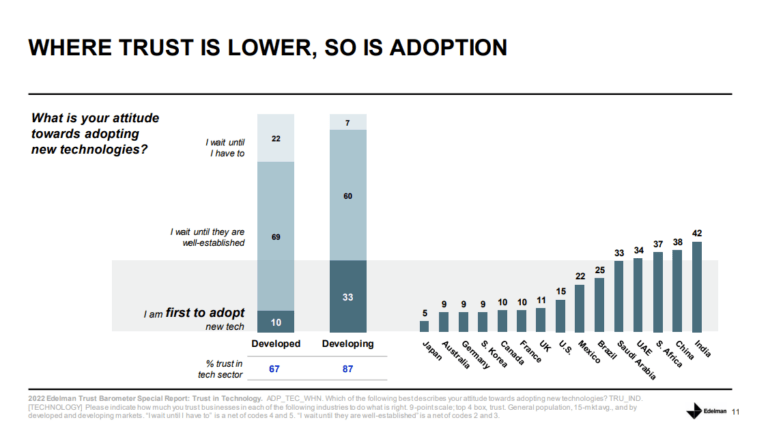
In the U.S., only 42% of consumers expressed trust in AI, with even lower levels of trust for other emerging tech like cryptocurrency (30%), blockchain (35%), autonomous tech (37%), and web3 (38%).
Innovation and Social Impact
Most people believe that tech will be a force for good, serving to tackle current societal challenges. But there’s greater skepticism in developed markets about whether tech can help address complex issues such as discrimination, and others caused by the economic downturn.
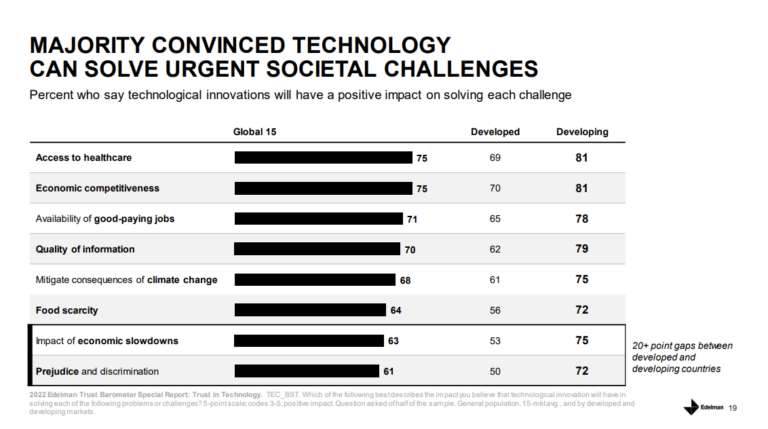
Distrust of Governments and Tech Platforms as Watchdog
Neither governments nor tech platforms are trusted as reliable protectors of consumer interests.
66% of those in developed countries lack trust in platforms to regulate their own online content, while 53% believe that government regulators don’t understand emerging tech well enough to regulate it effectively.
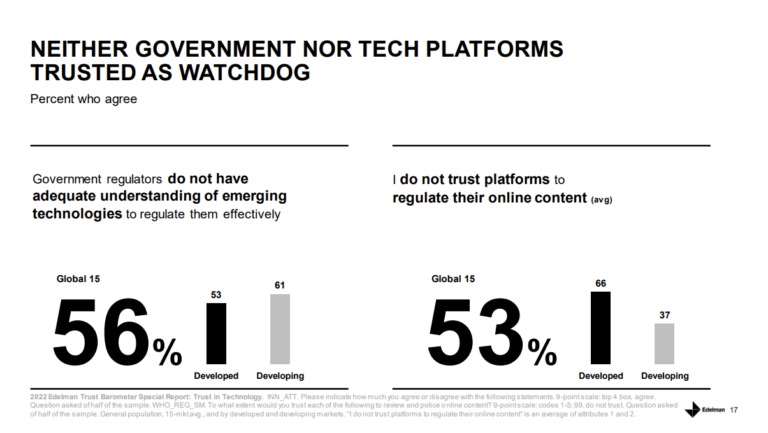
The decline in trust in the tech sector coincides with growing public pressure for more regulation and oversight. According to a poll conducted last year by the Public Affairs Council and Morning Consult, tech ranked 3rd among industries perceived to need more oversight, behind only big pharma and health insurance.
What Consumers Want
Edelman’s Trust Barometer Reports provide additional insights into what consumers expect and want from the tech sector. I’ve pulled out the most relevant bits below, but you can always dive deeper for industry-specific insights.
Data Privacy, Protection and Control
Data privacy and protection is the biggest concern for consumers. They want clarity and transparency about data collection practices, more control over their data, and expect quick action in the case of a breach.
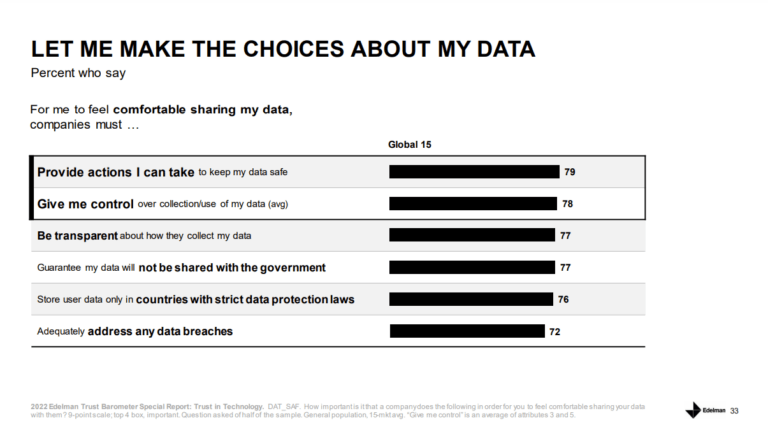
Clear Explanation of Benefits and Risks for New Tech
To gain consumer trust, tech companies need to better explain the benefits (41%) and transparently disclose the risks (38%) of new technologies to gain trust.
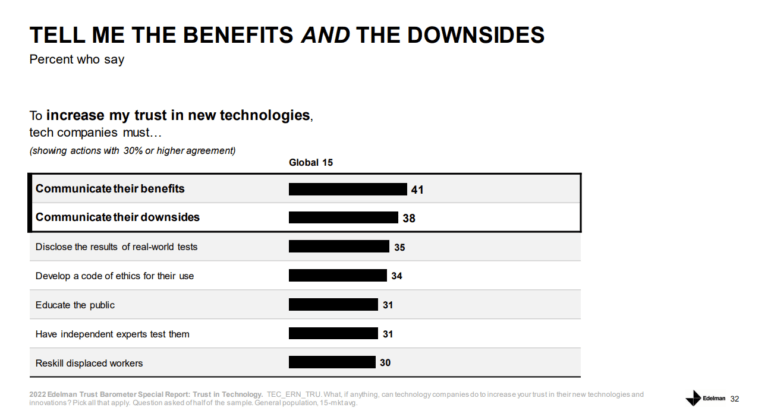
Trusted Spokespeople
Word-of-mouth from friends and family (63%) carries the most weight when it comes to shaping consumer perceptions of tech and innovation, demonstrating the influence of social networks on credibility. Workplace IT support and tech (62%) industry experts also rank highly (60%).
Tech CEOs, on the other hand, are not seen as credible voices.
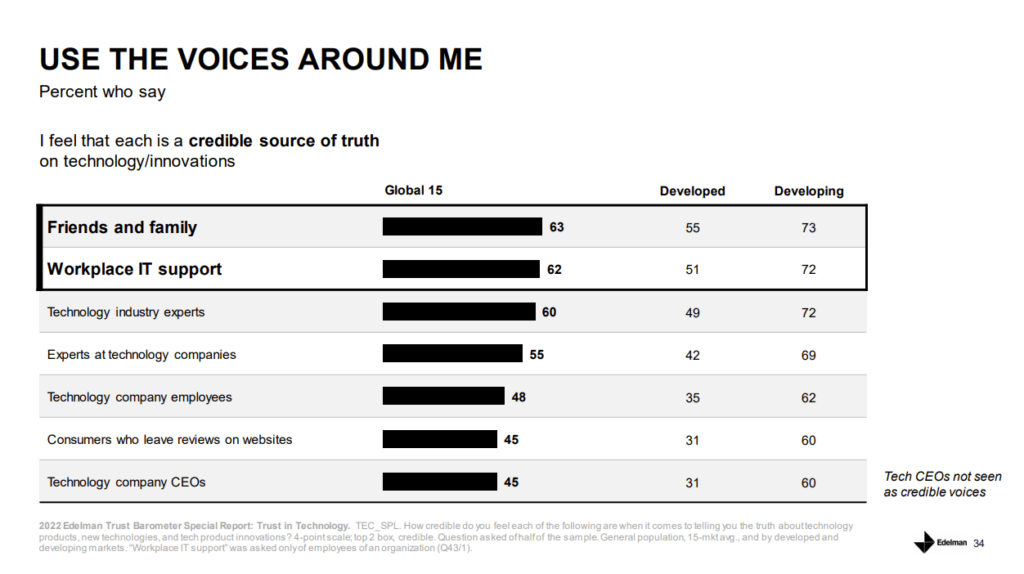
The Data Paradox: Privacy vs. Personalization & Convenience
Although data privacy and protection consistently top the list of consumer concerns, it’s worth noting a seemingly contradictory insight.
As consumers, we’re increasingly aware of the price we pay for providing our data to access “free” apps and content. It might seem like this undermines our demand for data protection and privacy. But, that’s not the case.
A survey by Google and BCG found that while 45% of North Americans are uncomfortable with sharing their data for personalized ads, two-thirds want their ads to be personalized to their interests. But they’re much less comfortable with data being shared with other companies, and especially with it being sold.
As a piece in The Verge notes, “People sacrifice some measure of privacy for convenience – be that the big booby anime version of yourself (referencing Lensa) or a speaker that’s constantly listening for your voice.”
TikTok’s popularity continues to surge, in spite of increased security concerns and warnings. The app’s algorithm creates a personalized experience for its users by taking into account their likes, views, interests and profile information. This ability is key to its addictive nature, and the reason content creators, users and marketers continue to flock to the app.
Despite our discomfort with sharing our personal information, we’re willing to compromise when the perceived rewards outweigh the perceived cost. This often means giving up some privacy in exchange for convenience, personalized and frictionless experiences, “worthwhile” discounts or other desirable benefits.
We consider it a “necessary evil.”
And we’re more comfortable sharing certain types of data, like gender, age, zip code, and email address than others like our phone number, location, or online browsing activity.
But these findings aren’t universal. They vary significantly across consumer segments. New parents, for example are 70% more willing to share their income than the average consumer, but 43% less willing to share their activities on other websites. So, it’s important to factor these unique preferences into the data collection strategy.
Based on data from Tinuiti’s Privacy Study 2022, a majority (64%) of US consumers are willing to share their email address in exchange for a $20 coupon or discount, while 31% would also share their full name.
Despite our security concerns and personal preferences, we also understand that even the best security systems can sometimes fail. In these cases, what matters most to us is the response. We want quick, transparent communication and the assurance that the brand is both sincere and competent in protecting our interests.
Ultimately, we’re rooting for the tech industry to figure out how to provide us with meaningful experiences without compromising our well-being. A true win-win.
Emerging Tech and Web3: The Roots of the Consumer Trust Dilemma
Lack of trust seems to be a big problem for the entire tech industry, and particularly a tricky one for emerging tech, and web3. But, why? Let’s investigate its origins.
Distrust of Technology Overall
Our fear and distrust of technology has a long history, often reflected in the arts.
Mary Shelley’s Frankenstein, a pioneering work of science fiction published in 1818, explores the dangers of technology surpassing human control.
And more recent films like Blade Runner, Ex Machina, and the HBO series Westworld echo these concerns while delving into the complex relationship between creator and creation, and the risks and responsibilities that come with pushing the boundaries of innovation.
As AI technology continues to advance rapidly, the relevance of these themes grows ever more pressing. With big power comes big responsibility. And big questions about the reliability, security and the dangers of these potent yet untested technologies. And of course, a much greater need for clarity on how the tech will be used.
New capabilities often bring new threats, The Verge notes. “ Will the creative industries be decimated by the spread of generative AI? Is machine learning going to create a tsunami of spam that will ruin the web forever? And what about the inability of AI language models to distinguish fact from fiction or the proven biases of AI image generators that sexualize women and people of color? Some of these problems are known; others are ignored, and still, more are only just beginning to be noticed.”
So at this point, we don’t even know what’s possible nor what we’re actually dealing with. And that’s both exciting and scary.
Distrust of Big Tech
We have pretty good reasons not to trust big tech.
High-profile data breaches at major companies like Google and Yahoo have sparked concerns about data privacy and security, while others including Facebook have faced backlash for unethical advertising practices using consumer data.
Some tech giants, like Microsoft and Uber have also been criticized for their lack of transparency about how their technology is developed and used.
And let’s not forget about the abuse of market power by the likes of Amazon, Apple and Google, which has already led to regulatory action.
Abuse of market power refers to the use of a dominant market position to gain unfair advantages over competitors or disadvantage consumers, leading to fewer choices or higher prices. This can take many forms, including predatory pricing, anti-competitive agreements, and even the enforcement of ongoing consumer surveillance.
As the” techlash” continues to gain stream, with increasing scrutiny on privacy blunders and the impact of social media on elections, the pressure for regulation is mounting. It’s clear that for big tech, profit often takes precedence over consumer needs and interests.
Distrust of What We Can’t Yet Understand
We all crave familiarity, simplicity, and clarity. And we’re naturally wary of what we don’t understand.
This is especially true when it comes to emerging technologies which are inherently new, complex, uncertain and untested.
The foundational ideas of web3, from a decentralized internet to blockchain to crypto, as well as the technical aspects of the “tech” itself, are complex. This makes the concepts difficult to explain, and even harder for non-techies to understand.
Most user interfaces are clunky and difficult to navigate, causing the user experience to become unwieldly and confusing. This further discourages engagement, experimentation, and learning.
And then, there’s all the hype, misinformation, and fraud in the crypto, NFT and web3 space, which has fueled consumers’ fears and concerns about the integrity of the companies in the space.
As it stands, web3 is seen as a daunting and intimidating space for consumers.
Who can blame them?
Distrust of Ourselves
Since the dawn of time, we have demonstrated our tendency to prioritize our own greed and self-interest at the expense of others. And to deceive, cheat, and scam each other.
This has led to many instances of insider trading, doping in sports, political interference, and other forms of deceit that have undermined our collective trust in society.
We’ve learned that we can’t always trust each other. And at times, we might even struggle to trust ourselves.
Afterall, we are merely human.
On Data Protection, Ownership & Control: The Big Promise of Web3
In the new era of tech, where data privacy is the top concern among consumers and the biggest challenge facing the industry, web3 brands have a huge opportunity. Why?
Because they already have a leg up when it comes to data protection, thanks to their promise: to create a future in which data is connected, individual privacy and ownership rights are respected, incentives are aligned, and trust is inherent.
And transparency – a core part of web3’s DNA, is a highly value attribute by consumers.
So, web3 brands are in prime position to gain a competitive edge, if…they can actually build trust.
But is it possible to build trust with consumers in the web3 world as things stand?
And isn’t web3 supposed to be trustless anyway?
Trust and Web3
As we’ve discussed, trust is fundamental to the fabric of our society and the cornerstone of our relationships. But in the world of crypto and web3, trust is a complex and often controversial topic.
The underlying value of crypto is trustlessness, which refers to the idea that we don’t need to rely on traditional institutions or third parties to protect assets or facilitate transactions. We can, instead, use cryptographic proof to ensure the integrity and security of our transactions.
Trustlessness means that we can facilitate transactions without having to rely on trust. In this way, crypto promises to eliminate the need for trust.
But as we’ve seen, this is easier said than done.
Why Isn’t Trustlessness Possible?
The web3 ecosystem relies on certain elements of trust to function as intended. The trust triangle is a well-known concept in the world of crypto, consisting of three sides: user, platform, and regulator.
The idea is that all three sides must be trusted in order for a crypto transaction to be secure. If one of these sides is not trusted, then the other two sides must step in to ensure the transaction is secure, which requires trust in those sides.
But what are the factors that challenge the balance of the trust triangle, and in turn the entire concept of trustlessness?
And what happens when trust has been broken?
Theories vs. The Real World
Theories often simplify and abstract from real-world complexity and nuances.
The world of web3 – including decentralized tech like the blockchain and crypto – doesn’t exist in isolation. It has many points of interaction with the real world, and at these intersections, trust becomes necessary.
The web3 ecosystem must navigate the complexities of interacting with traditional financial systems and governments. And grapple with the realities of their influence in the form of policies and regulations, which can compromise privacy and create high levels of uncertainty.
And then there are the intricate and complex layers of human psychology which drive every decision and action.
All of these factors contribute to the challenges of making the theory of trustlesness a real life practicality.
Let’s explore them in greater detail.
Regulation, Fraud & Human Psychology
In the real world, we rely on regulatory authorities to ensure that the companies we interact with are acting ethically and in our best interests. But crypto has been in a “move fast and break things” mode, leading to a lot of broken things before regulators can catch up.
But this isn’t unique to web3. Nearly all emerging technology in a new frontier faces similar circumstances which leads to a higher risk of fraud because:
And in the world of web3, regulation is still a murky area. Many crypto platforms have collapsed or taken advantage of their users, and regulators have been too slow to catch up and take action.
On the other hand, lack of clarity in regulation and future policies have created high levels of risk and uncertainty for users. For example, governments may impose taxes on crypto transactions or regulate the use of decentralized exchanges. This creates increased unpredictability for consumers and also influences the way the web3 ecosystem functions and evolves.
Trust is very fragile now in the web3 world. A single event or revelation – like a hack, security breach or instance of fraud – can undermine trust in a platform and shake the foundation of the entire ecosystem. The FTX scandal is a good example of this. The high level of volatility makes it difficult to maintain trust in the triangle.
This is particularly true when it comes to custodial assets. These are assets that are held by a third party, like a bank or a crypto exchange. In order to use these assets, we need to trust that our custodians will competently and reliably manage our assets and act in our best interests.
But even with custodial assets, trust is not a guarantee. There have been numerous instances of exchanges being hacked or going bankrupt, leaving users with little recourse. And even if an exchange is competent and technically reliable, there’s no guarantee that it will act with integrity. In some cases, exchanges have been known to engage in insider trading or manipulate prices to their own benefit.
Also, although consumers are generally wary of emerging tech like crypto, or financial products they don’t understand, some still trusted crypto platforms because they looked like banks. And consumers are familiar with how banks work. And familiarity breeds trust. Plus, these platforms promised to pay them back, despite their lack of transparency and high leverage.
This highlights the importance of the psychology piece when it comes to trust. We’re used to trusting institutions like banks, and that trust is pivotal to our decision-making processes, especially decisions that involve our money.
This puts the promise of trustlessness at odds with our reliance on trust in institutions in the real world.
And there is another important tension at play which deepens the conflict: the one between the underlying tech and privacy.
The Tug-of-War between Blockchain and Data Privacy
There are two components to the privacy-related tension at the heart of web3
Privacy vs. Transparency
The transparent nature of public blockchains makes transactions visible to all. While this level of transparency is often seen as a key benefit of blockchain technology, it also poses notable privacy risks for us when interacting with the real world. And these risks aren’t often clear or obvious to us.
When we want to use our crypto to buy stuff, we often have to give up some privacy. To make an online purchase, for example, we may need to create an account on a centralized exchange, like Coinbase, and provide our personal info including our name, email address, and phone number.
Or, to make a purchase at a physical store that doesn’t accept crypto, we’ll likely need to use a centralized payment service to convert our crypto into fiat currency – such as dollars or euros. This process also requires us to provide personal and financial details.
Our interactions within our web3 communities further compromises our privacy. Even seemingly innocent actions like claiming membership benefits or interacting with others can have unintended consequences. When we give up our name or member number in order to claim a community benefit, for example, we may also be giving others access to our wallet activity. This information can be linked back to our identity within the community, making it challenging to maintain anonymity, even if we’re using a pseudonym.
Collaborating with community members may require storing joint assets in the same wallet, without the option to separate them for more privacy in a personal wallet.
And things can get pretty tricky within groups since accepted social practices haven’t been established yet in this realm.
According to a recent paper by researchers at Brave and Imperial College London, many decentralized finance (DeFi) apps use third-party web services that can access users’ Ethereum addresses. And these addresses can be potentially linked to individuals’ personally identifiable information (PII). “We find that several DeFi sites rely on third parties and occasionally even leak your Ethereum address to those third parties – mostly to API and analytics providers.” One tracker was able to access Ethereum addresses on 56% of the 78 DeFi sites examined.
The researches warned that third-party companies can potentially link the Ethereum addresses to other user information they already posses. “Ethereum address leakage to Google is particularly problematic because the company likely already has PII about you, which it can then link to your Ethereum address, which can then be linked to your transaction history on the blockchain.” “Ethereum addresses constitute sensitive, private information, akin to credit cards and bank account numbers,” they added.
This highlights the need for careful consideration of privacy when it comes to sharing data with third parties. And things become further complicated by the current state of regulation and data protection laws.
Blockchain Technology vs. Data Protection Laws
The blockchain’s core capabilities – like encryption and data verification – can help address privacy concerns. But the tech’s lack of central control, and the fact that data can’t be altered, and is stored indefinitely puts it in it at odds with current data protection laws.
In addition, blockchain technology and data privacy laws have largely evolved separately, which can create additional complications when trying to integrate them, especially in the early stages.
Below are some of the key factors that contribute to the tensions between the tech and current data privacy laws:
The privacy related challenges are multilayered, and many answers are still unclear. That’s just part of the territory with bleeding-edge tech.
The regulatory, fraud, and privacy issues we’ve discussed so far make it difficult to keep the trust triangle stabilized in the web3 ecosystem. So, while web3 can offer some level of trustlessness, it’s unlikely that it will ever eliminate the need for trust.
In reality, trust is an inescapable part of the equation.
Are there fundamental strategies that can help web3 brands deliver on their promise? I believe so.
But before we dive into those, let’s do a quick review of the top challenges that contribute to consumer distrust in this new and unfamiliar landscape, so we can have them top of mind as we strategize.
Building Consumer Trust: The Challenges Facing Web3 Brands
The below list below outlines an initial list of challenges for building consumer trust in web3. As things continue to evolve, we’ll need to update it. It’s also important to note that many of these obstacles are influenced by dynamics outside of a single brand’s control, such as overall market conditions, industry trends, the political climate and other socioeconomic and cultural factors.
Web 3 and Data Privacy: Strategic Considerations
To navigate the tensions between decentralized technologies and data privacy regulations, it’s essential to carefully consider and evaluate various approaches and risk management strategies as part of the company’s strategy development process. I’ve included some suggestions below, as a starting point.
Key Strategies for Building Trust in Web3
Ok, let’s see if we can make sense of all we’ve reviewed so far, and find a fitting path forward.
Building consumer trust is a long-term game, because trust is earned one meaningful interaction and experience at a time. It takes commitment, and consistency.
Navigating the complex challenges of the web3 ecosystem is not for the faint of heart. But it’s proof of a resilient and reliable ecosystem and the mark of true legitimacy.
There are two key components to the umbrella strategy of building trust in web3:
- Build: Build trust into the core of a brand’s ecosystem, business lifecycle and processes, and all consumer touchpoints.
- (Over) Communicate: Prioritize transparent communication of brand values, practices, processes, and policies with emphasis on trust as the core
And as we’ve discussed, the tension between transparency and privacy creates complex challenges for gaining consumer trust. And there’s no one-size-fits-all solution. Each company will have to figure out its own stance on privacy and security based on their unique needs of its products, services and business models.
Ultimately, however, the promise of web3 to reshape data privacy hinges on two invaluable factors: The freedom of choice and transparency with consumers. And we should keep them in mind as we strategize.
I’d also like to add a caveat. Although I’ve been studying the web3 space for a bit, I’m still new to it, and still learning, a lot.
My intention is to combine what we’ve learned from the data with my expertise in building brand trust as a strategist and my understanding of human psychology, and apply it to the current web3 landscape. I hope this will lead to more questions we can explore together.
And with that, below are my strategic recommendations for building brand trust in web3.
Trust at the Heart
Build trust into the core of your brand’s ecosystem, lifecycle, touchpoints and communications.
Build
(Over) Communicate
Build
(Over) Communicate
Deliver high quality products & value driven experiences that solve real problems, build goodwill, and fuel word of mouth: Strong relationships and communities of genuine advocates serve as the best line of defense against crisis or breaches of trust.
Improve User Experiences to Reduce Friction:
Develop clear messaging strategies and campaigns that highlight the unique benefits of your products and services.
Ensure messaging is consistent across all touchpoints and platforms.
Establish Feedback Loops: Create streamlined processes to continuously gather and incorporate consumer feedback and insights to enhance products, services and overall user experience.
Provide customer support. With real humans.
Establish an accessible, consumer-friendly culture.
Emphasize the brand’s people-first approach to service, and accessible culture at all touchpoints to provide clarity and enhance consumer confidence.
Develop ethical business practices, processes and policies: Ensure all including actions and decisions are guided by consumer trust as the priority.
Limit partnerships to trusted brands:
Disclose Business Practices and Policies: Promptly address concerns as they arise. Offer accurate and practical information to help consumers make decisions.
Cleary and publicly communicate partnership criteria.
Find and engage with your audience on platforms where they spend their time vs. those historically associated with core web3 community
Privacy by Design: Integrate privacy into every aspect of your business including design, infrastructure and processes.
Clearly communicate your Privacy by Design approach and all privacy risks (especially the non-obvious ones) across the ecosystem and all consumer touchpoints.
Educate consumers:
Clearly communicate the benefits, drawbacks and risks of products and services, especially for new tech.
Sources and Resources
2022 Special Report: Trust in Technology | Edelman
2021 Edelman Trust Barometer Special Report: Trust -The New Brand Equity
2020 Edelman Trust Barometer Special Report: Brand Trust in 2020
2021 Public Affairs Pulse Survey Report: What Americans Think About Business and Government
2002 Axios Harris Poll 100 Rankings
2022 Cisco Consumer Privacy Survey
2021 Brave Research Paper: Privacy and Security Issues in Web 3.0
Blockchain Technology: Data Privacy Issues and Potential Mitigation Strategies

